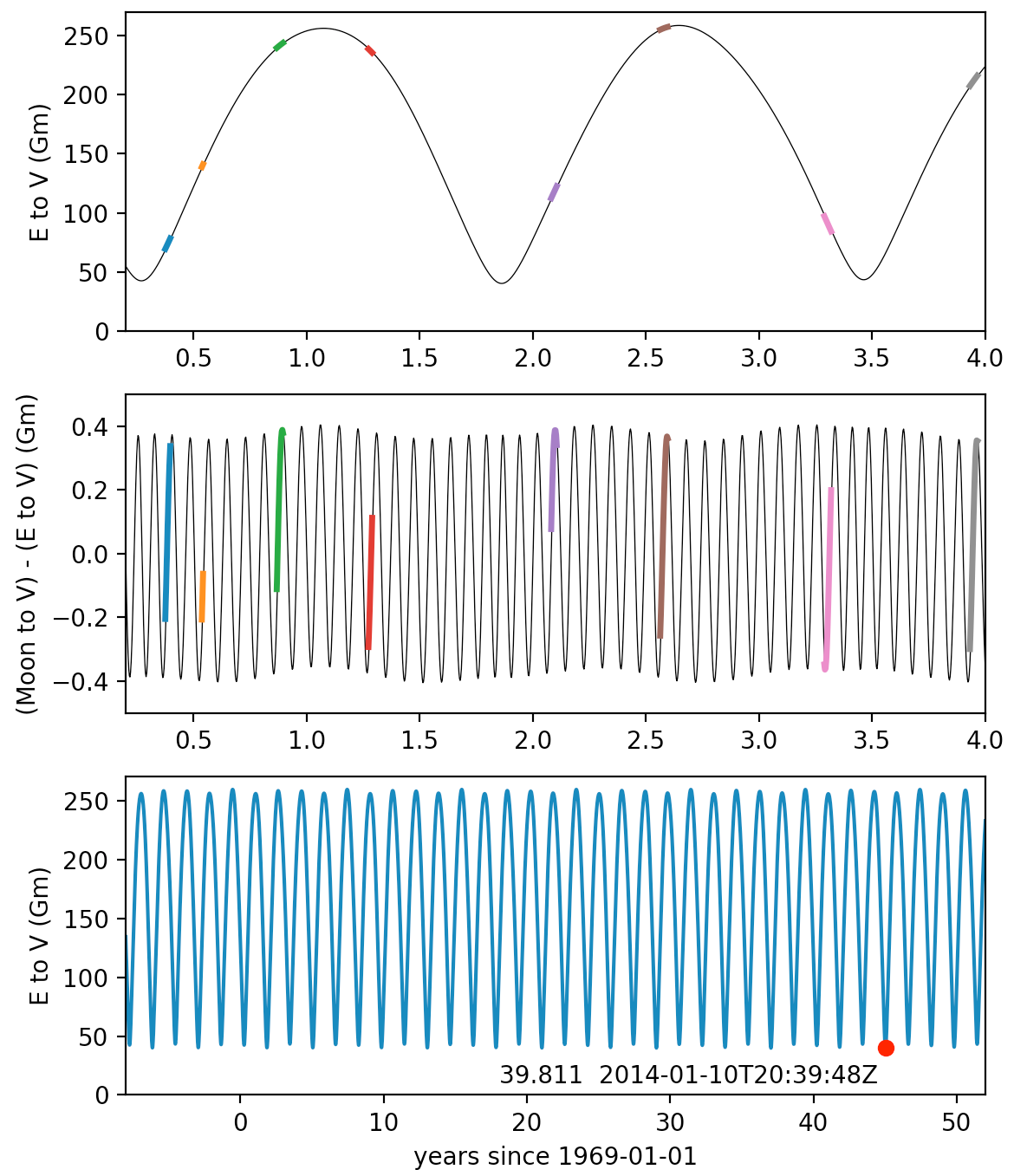Supplemental answer for parity's sake.
I can verify that it wasn't any Apollo-era astronauts
Similar to this answer for Mars:

from skyfield.api import Topos
from skyfield.api import Loader
import numpy as np
import matplotlib.pyplot as plt
from skyfield.api import load
loaddata = Loader('~/Documents/fishing/SkyData') # avoids multiple copies of large files
ts = loaddata.timescale() # include builtin=True if you want to use older files (you may miss some leap-seconds)
eph = loaddata('de421.bsp')
earth, moon, venus = [eph[x] for x in ('earth', 'moon', 'venus')]
apollos = [(10, 1969, 5, 18, 26), (11, 1969, 7, 16, 18),
(12, 1969, 11, 14, 24), (13, 1970, 4, 11, 17),
(14, 1971, 1, 31, 40), (15, 1971, 7, 26, 38),
(16, 1972, 4, 16, 27), (17, 1972, 12, 7, 19)]
# https://en.wikipedia.org/wiki/Apollo_program
timez_apollo = []
for n, year, month, d_start, d_stop in apollos:
times = ts.utc(year, month, range(d_start, d_stop+1))
timez_apollo.append(times)
days = 1 + np.arange(5*365.2564+1)
times = ts.utc(1969, 1, days)
years = days/365.2564
t_1969 = times.tt[0]
epos, moonpos, vpos = [x.at(times).position.km for x in (earth, moon, venus)]
r_earth = np.sqrt(((epos - vpos)**2).sum(axis=0))
dr_moon = np.sqrt(((moonpos - vpos)**2).sum(axis=0)) - r_earth
fig = plt.figure()
ax1 = fig.add_subplot(3, 1, 1)
ax2 = fig.add_subplot(3, 1, 2)
ax3 = fig.add_subplot(3, 1, 3)
ax1.plot(years, r_earth/1E+06, '-k', linewidth=0.5)
ax2.plot(years, dr_moon/1E+06, '-k', linewidth=0.5)
for timez in timez_apollo:
yearz = (timez.tt - t_1969) / 365.2564
epoz, moonpoz, vpoz = [x.at(timez).position.km for x in (earth, moon, venus)]
r_earthz = np.sqrt(((epoz - vpoz)**2).sum(axis=0))
dr_moonz = np.sqrt(((moonpoz - vpoz)**2).sum(axis=0)) - r_earthz
ax1.plot(yearz, r_earthz/1E+06, linewidth=2.5)
ax2.plot(yearz, dr_moonz/1E+06, linewidth=2.5)
ax2.set_ylim(-0.5, 0.5)
ax1.set_xlim(0.2, 4.0)
ax2.set_xlim(0.2, 4.0)
ax1.set_ylim(0, None)
timesbig = ts.J(np.arange(1961, 2021, 0.001))
eposbig, vposbig = [x.at(timesbig).position.km for x in (earth, venus)]
r_earthbig = np.sqrt(((eposbig - vposbig)**2).sum(axis=0))
yearsbig = (timesbig.tt - t_1969) / 365.2564
ax3.plot(yearsbig, r_earthbig/1E+06)
closest = np.argmax(-r_earthbig)
ax3.plot(yearsbig[closest:closest+1], r_earthbig[closest:closest+1]/1E+06, 'or')
print(timesbig.utc_iso()[closest])
message_left = str(round(float(r_earthbig[closest:closest+1])/1E+06, 3))
message_right = timesbig.utc_iso()[closest]
message = message_left + ' ' + message_right + ' '
ax3.text(yearsbig[closest], 10, message, ha='right')
# ax3.text(yearsbig[closest], 10, message_right, ha='left')
ax3.set_xlabel('years since 1969-01-01')
ax3.set_xlim(yearsbig[0], yearsbig[-1])
ax3.set_ylim(0, None)
ax1.set_ylabel('E to V (Gm)')
ax2.set_ylabel('(Moon to V) - (E to V) (Gm)')
ax3.set_ylabel('E to V (Gm)')
plt.show()
